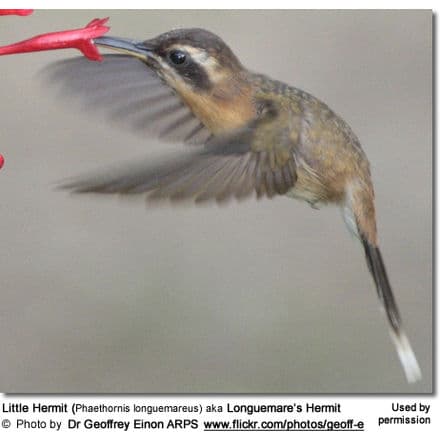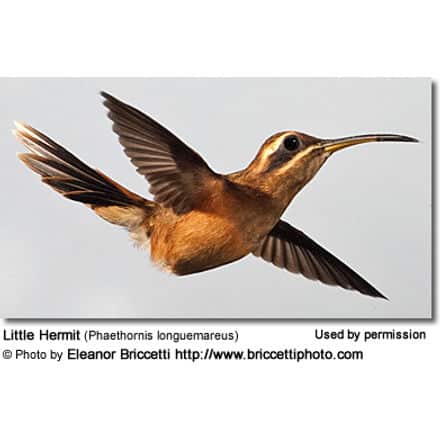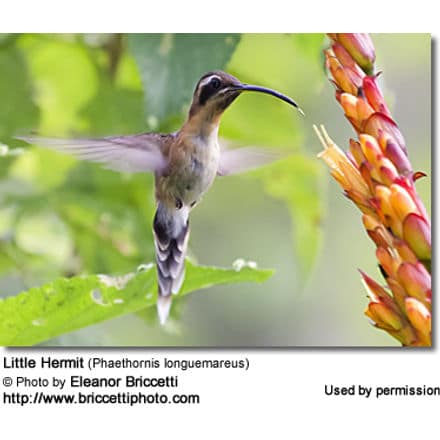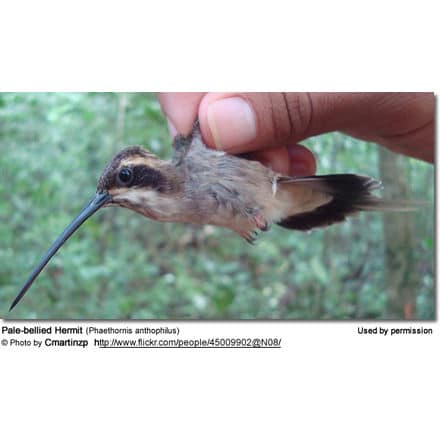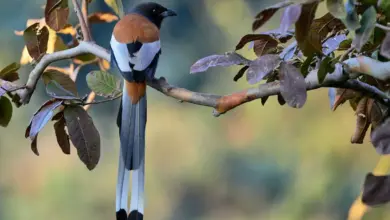Little Hermits
Little Hermits
Hummingbird Information
The Little Hermits (Phaethornis longuemareus) – also known as Longuemare’s Hermit – is a small South American hummingbird that is found in north-eastern Venezuela, northern Guyana, Suriname, French Guiana and Trinidad. It is fairly common within its range.
They occur in low and middle elevation forests, on Caribbean and Pacific slopes; where they inhabit semi-open wooded habitats, mangroves, secondary forests, plantations, scrubland as well as gardens. They usually stay close to water and favored feeding areas. In Trinidad, they are also found in the rainforest.
Alternate (Global) Names
Spanish: Ermitaño Chico, Ermitaño Enano … Portuguese: Rabo-branco-de-garganta-escu, Rabo-branco-de-garganta-escura … French: Ermite de Longuemare, Ermite nain … German: Zwergeremit … Czech: Kolibrík trpaslicí, kolib?ík trpasli?í … Danish: Dværgeremit, Sortstrubet Dværgeremit … Finnish: Erakkokolibri … Italian: Eremita minore … Japanese: kobitoyumihachidori … Latin: Phaethornis atrimentalis, Phaethornis longuemareus longuemareus … Dutch: Kleine Heremietkolibrie, Kleine Hermietkolibrie … Norwegian: Småeremitt … Russian: ????????? ??????? ????????? … Slovak: slnecnícek hrdzavý … Swedish: Mindre eremit
Description:
The Little Hermit is among the smallest hummingbirds with a total length ( including beak and tail) of 9 – 10 cm (3½ – 4 inches) and a weight of 2½-3½ g. (0,08 – 0,12 oz).
Its black bill is long and slightly down-curved; the upper beak is black and the lower is yellow with a black tip.
The Little Hermit has black and light facial stripes. The male’s throat is slightly darker than the female’s.
The upper plumage is olive-green with orange or cinnamon-colored upper-tail coverts (feathers) . The under plumage is also a cinnamon color with a greyish tint it. Its tail is brownish with whitish tips.
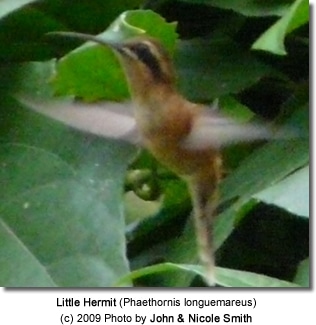
Male will perform in communal leks (competitive mating displays or dancing grounds) where they sing and flash their tails to attract the females. Their display may entail wiggling of their tails and singing. Willing females will enter the area for the purpose of choosing a male for mating. Oftentimes she will choose the best singer.
He will separate from the female immediately after copulation. One male may mate with several females. In all likelihood, the female will also mate with several males. The males do not participate in choosing the nest location, building the nest or raising the chicks.
The female is responsible for building the cone-shaped nest out of plant fibers woven together and green moss on the outside for camouflage in a protected location in a shrub, bush or tree or she may attach her .
The female is responsible for building the remarkable cone-shaped nest which hangs by a single strong string of spiders’ silk and/or rootlets from some overhead support, which could be a branch or the underside of the broad leaves of, for example, Heliconia plants, banana trees or ferns about 3 – 6 ft (1 – 2 m) above ground. However, these unusual nests have been found beneath bridges, in highway culverts and even hanging from roofs inside dark buildings. The nest is often near a stream or waterfall. It is constructed out of plant fibers woven together and green moss on the outside for camouflage in a protected location. She lines the nest with soft plant fibers, animal hair and feather down, and strengthens the structure with spider webbing and other sticky material, giving it an elastic quality to allow it to stretch to double its size as the chicks grow and need more room.
She lines the nest with soft plant fibers, animal hair and feather down, and strengthens the structure with spider webbing and other sticky material, giving it an elastic quality to allow it to stretch to double its size as the chicks grow and need more room. The nest is typically found on a low, thin horizontal branch.
She lays 1 to 3 white eggs (average 2) – which she incubates alone for about 14 to 16 days. The young are born blind, immobile and without any down.
The female alone protects and feeds the chicks with regurgitated food (mostly partially-digested insects since nectar is an insufficient source of protein for the growing chicks). The female pushes the food down the chicks’ throats with her long bill directly into their stomachs.
The chicks are brooded only the first week or two, and left alone even on cooler nights after about 12 days – probably due to the small nest size. The chicks leave the nest when they are about 20 – 23 days old.
Diet / Feeding
The Litte Hermits primarily feed on nectar taken from a variety of seasonal, brightly colored, scented, large flowers of trees, shrubs and epiphytes – with their favorite feeding plant being the broad-leafed Heliconia plant.
Hermits are “trap-line feeders” which means that they visit plants along a long route (in this case of up to 0.6 miles or 1 km) – as opposed to most other hummingbird species who are highly territorial and will aggressively protect, those areas containing flowers with high energy nectar.
They favor flowers with the highest sugar content (often red-colored and tubular-shaped) and seek out, and aggressively protect, those areas containing flowers with high energy nectar.They use their long, extendible, straw-like tongues to retrieve the nectar while hovering with their tails cocked upward as they are licking at the nectar up to 13 times per second. Sometimes they may be seen hanging on the flower while feeding.
Many native and cultivated plants on whose flowers these birds feed heavily rely on them for pollination. The mostly tubular-shaped flowers actually exclude most bees and butterflies from feeding on them and, subsequently, from pollinating the plants.
They may also visit local hummingbird feeders for some sugar water, or drink out of bird baths or water fountains where they will either hover and sip water as it runs over the edge; or they will perch on the edge and drink – like all the other birds; however, they only remain still for a short moment.
They also take some small spiders and insects – important sources of protein particularly needed during the breeding season to ensure the proper development of their young. Insects are often caught in flight (hawking); snatched off leaves or branches, or are taken from spider webs. A nesting female can capture up to 2,000 insects a day.
Males establish feeding territories, where they aggressively chase away other males as well as large insects – such as bumblebees and hawk moths – that want to feed in their territory. They use aerial flights and intimidating displays to defend their territories.
Metabolism and Survival and Flight Adaptions – Amazing Facts
Call / Vocalization:
The Little Hermit’s high, squeaky song varies over its range. It song is generally repeated several times.
Taxonomy
The Little Hermit is now considered monotypic (a genus consisting of only one species). Previously, several other small hermits were considered its subspecies – but they are now regarded as separate species. These are:
- the Stripe-throated Hermit (Pygmornis striigularis) of Central America and northwestern South America,the Minute Hermit (Pygmornis idaliae) of southeastern Brazilthe Black-throated Hermit (Pygmornis atrimentalis) of western Amazonia in Colombia, Ecuador and Peru.
Species Research by Sibylle Johnson
Please Note: The articles or images on this page are the sole property of the authors or photographers. Please contact them directly with respect to any copyright or licensing questions. Thank you.

